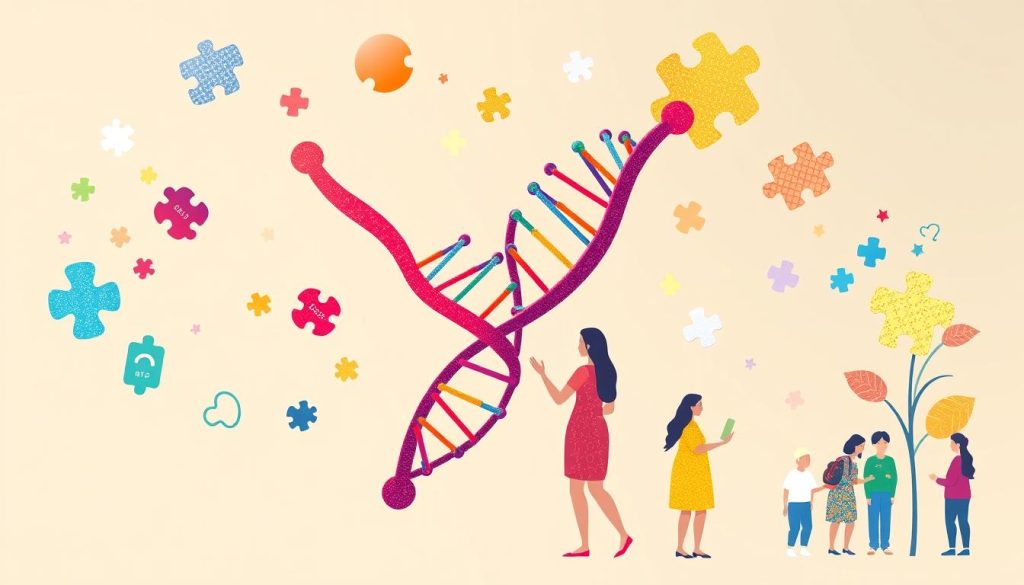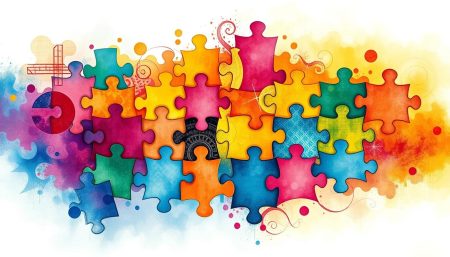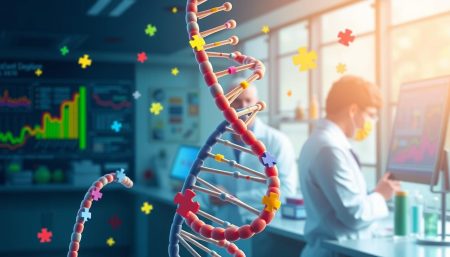The world of autism genetics is complex and fascinating. Scientists have long puzzled over the origins of neurodevelopmental disorders like autism. One burning question remains: Does the autism gene come from mom or dad?
Genetic risk factors play a big role in autism spectrum disorders. But finding the exact source isn’t easy. Both parents can pass on genes that increase the chance of autism. Understanding these patterns is key to solving the mystery of autism genetics.
As we explore this topic, we’ll look at the complex mix of genetic and environmental factors that affect autism risk. Join us on this journey through the latest research and discoveries in autism genetics.
Understanding Autism’s Genetic Foundations
Autism is a complex disorder with strong genetic roots. Research shows that both familial autism and genetic risk factors play a big role in its development. Scientists have made significant progress in uncovering the genetic foundations of autism spectrum disorders.
The Role of DNA in Autism Development
DNA forms the blueprint for our bodies and brains. In autism, certain genetic variations can affect brain development and function. These changes may occur in genes that control how brain cells communicate or grow. Some people inherit these variations from their parents, while others develop new mutations.
Key Genetic Markers Associated with Autism
Scientists have identified several genetic markers linked to autism. These include:
- Chromosomal abnormalities, such as deletions or duplications of DNA segments
- Mutations in genes like SHANK3, CHD8, and SCN2A
- Variations in genes involved in brain cell communication
Each of these markers can contribute to the risk of developing autism.
How Genes Influence Brain Development
Genes guide the formation and function of the brain from early fetal development through adulthood. In autism, genetic variations can affect how brain cells grow, connect, and communicate. This can lead to differences in brain structure and function, resulting in the behavioral and cognitive traits associated with autism spectrum disorders.
Understanding these genetic foundations is key for developing better diagnostic tools and treatments for autism. As research progresses, we gain more insight into the complex interplay between genes and autism development.
Who Carries the Autism Gene Mother or Father
The debate on whether maternal inheritance or paternal inheritance is more significant in autism is ongoing. Both parents can pass on genes that increase the risk of autism. This makes familial autism a complex condition.
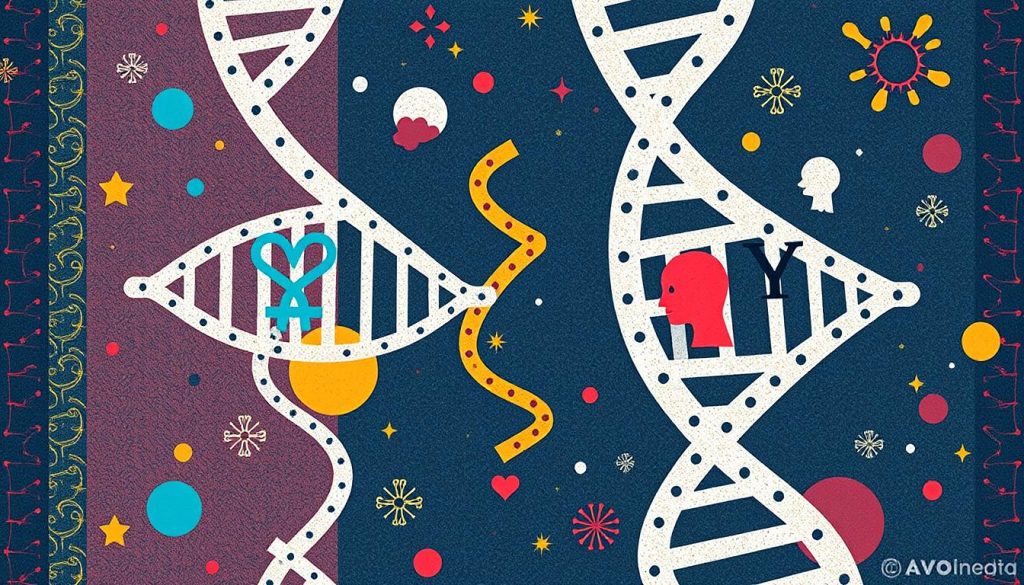
Studies have found that autism can come from either parent. Sometimes, maternal inheritance might have a bigger role, while other times, paternal inheritance is more important. It’s clear that both parents’ genes work together in complex ways to influence a child’s autism risk.
Recent research has uncovered the roles of each parent:
| Inheritance Type | Key Findings |
|---|---|
| Maternal Inheritance | X-chromosome linked genes, mitochondrial DNA variations |
| Paternal Inheritance | De novo mutations, advanced paternal age risk |
| Combined Inheritance | Multiple gene interactions, epigenetic factors |
Familial autism patterns often show a mix of traits from both parents. This complexity underlines the importance of detailed genetic testing and counseling for families dealing with autism spectrum disorders.
Maternal Genetic Contributions to Autism Risk
Mothers are key in passing on genetic traits to their kids, including those related to autism. Learning about how mothers pass on these traits helps us understand autism risk.
X-Chromosome Inheritance Patterns
The X-chromosome, one of two sex chromosomes, comes from the mother in male children. This unique pattern can affect autism risk. Genes on the X-chromosome linked to autism traits make maternal inheritance very important.
Mitochondrial DNA and Autism
Mitochondrial DNA, passed only from mother to child, might play a role in autism. Studies show that changes in mitochondrial DNA can impact brain function and lead to autism symptoms. This shows why studying maternal genetic factors in autism is vital.
Mother’s Age Impact on Genetic Risk
The mother’s age at conception can affect the risk of genetic problems in children. As women get older, the risk of genetic mutations goes up, possibly increasing autism risk. Here’s a table showing how maternal age affects autism risk:
| Maternal Age | Relative Autism Risk |
|---|---|
| Under 25 | Baseline |
| 25-29 | 1.2x |
| 30-34 | 1.5x |
| 35-39 | 1.8x |
| 40 and above | 2.2x |
Knowing these genetic contributions from mothers helps researchers find better ways to detect and treat autism early.
Paternal Age and Autism Gene Expression
Recent studies have found a link between paternal age and autism risk. As men get older, their sperm cells gather genetic mutations. These changes can affect how genes are passed down and raise the risk of neurodevelopmental disorders like autism.
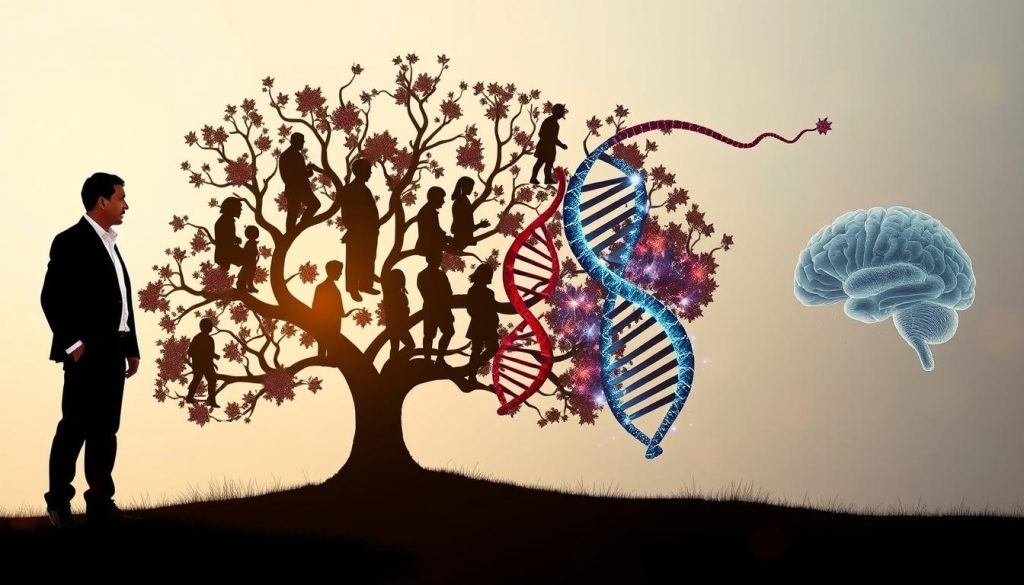
Research indicates that fathers over 40 are more likely to pass on genetic mutations to their kids. These mutations can impact brain development and lead to autism spectrum disorders. The risk grows with each year of paternal age, making it a key factor in family planning.
Scientists have pinpointed certain genes that are more likely to mutate in older fathers. These genes are involved in brain cell communication and growth. When they mutate, they can disrupt normal brain development, possibly causing autism-related traits.
- Increased de novo mutations in sperm cells
- Higher risk of autism in children of older fathers
- Specific genes prone to age-related mutations
Understanding the connection between paternal age and autism gene expression is vital for genetic counseling. It aids families in making informed choices about when to have a child and the risks involved. This knowledge also helps researchers find targeted treatments for autism spectrum disorders.
Complex Inheritance Patterns in Autism Spectrum Disorders
Autism genetics is a complex field. The way autism is passed down in families doesn’t follow simple rules. Many genes work together to shape how autism develops. This makes it hard to predict who might have autism based on family history alone.
Multi-Gene Interactions
In autism, lots of genes talk to each other. Some genes make autism more likely. Others might protect against it. It’s like a big puzzle where each gene is a piece. We’re trying to figure out how all these pieces fit together.
De Novo Mutations
Sometimes, new gene changes pop up out of nowhere. These are called de novo mutations. They aren’t passed down from parents. Instead, they happen when the egg or sperm is made. These mutations can play a big role in autism risk.
Inherited vs. Spontaneous Genetic Changes
Some genetic changes linked to autism run in families. This is familial autism. Other times, changes happen on their own. Both types can lead to autism. Chromosomal abnormalities can be inherited or happen randomly. Understanding these patterns helps doctors give better advice to families.
- Inherited changes: Passed down from parents
- Spontaneous changes: Occur randomly
- Both can affect autism risk
Studying these complex patterns helps us learn more about autism. It may lead to better ways to spot autism early and help those who have it.
The Role of Environmental Factors in Gene Expression
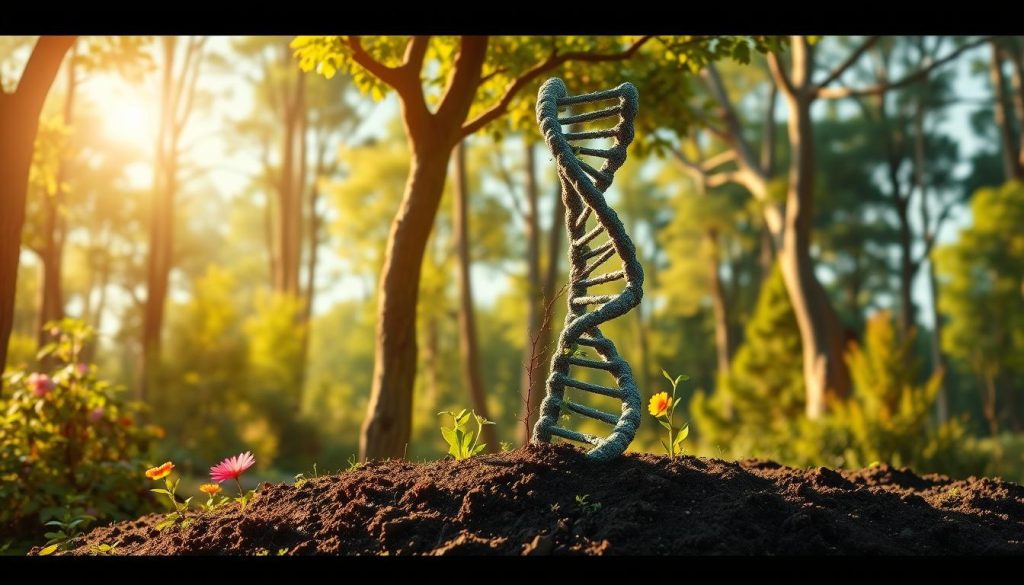
Genes don’t work alone in creating neurodevelopmental disorders like autism. Environmental factors greatly influence how genes are expressed. This mix of genes and environment is key to understanding autism development.
Studies reveal that many factors can change gene expression in autism. Prenatal risks such as older parents, maternal health issues, and infections can raise a child’s autism risk. These factors can alter gene function, possibly changing brain development.
Some environmental factors linked to autism include:
- Advanced parental age
- Maternal metabolic conditions
- Exposure to certain medications during pregnancy
- Maternal stress or mental health issues
Knowing these environmental influences is key for prevention and treatment. By finding these triggers, researchers aim to lessen their effect on autism and other neurodevelopmental disorders.
As we learn more about the connection between genes and environment, it’s clear autism isn’t just genetic. The mix of factors affects its development. This shows we need a broad approach to autism research and treatment.
Common Genetic Variants Associated with Autism
Autism genetics is key to understanding autism spectrum disorders. Scientists have found several genetic risk factors. Let’s explore three important genes that impact brain development and function.
SHANK3 Gene Mutations
SHANK3 gene mutations are found in about 1% of people with autism. This gene helps brain cells talk to each other. When it’s not working, it can lead to learning issues and repetitive behaviors seen in autism.
CHD8 Gene Variations
Changes in the CHD8 gene can lead to autism traits. This gene controls how other genes work during brain growth. People with CHD8 mutations may have larger heads and trouble sleeping.
SCN2A Gene Implications
The SCN2A gene is vital for brain cell communication. Mutations in this gene can cause autism and seizures. It’s one of the most common single-gene causes of autism, affecting brain development early on.
| Gene | Function | Autism Link |
|---|---|---|
| SHANK3 | Supports brain cell connections | Learning issues, repetitive behaviors |
| CHD8 | Controls other genes during brain growth | Larger head size, sleep problems |
| SCN2A | Helps brain cells communicate | Early brain development issues, seizures |
Understanding these genetic variants helps researchers develop better ways to diagnose and treat autism. While chromosomal abnormalities can play a part, these specific gene changes offer critical insights into autism’s complex genetic landscape.
Epigenetic Influences on Autism Development
Epigenetic changes are key in autism development. These changes alter how genes work without changing the DNA. Environmental factors can influence gene function, possibly leading to autism.
Research points to prenatal stress, maternal diet, and toxins as triggers. These can cause epigenetic changes. These changes might affect brain development and lead to autism.
Studies found specific epigenetic markers in autism. For instance, DNA methylation patterns differ in those with autism. These differences can impact gene expression and brain function.
| Environmental Trigger | Potential Epigenetic Effect | Impact on Autism Risk |
|---|---|---|
| Maternal stress | Altered DNA methylation | Increased risk |
| Prenatal nutrition | Changes in histone modifications | Variable impact |
| Toxin exposure | Disrupted gene expression | Elevated risk |
Exploring epigenetic influences on autism offers new research paths. By understanding environmental triggers and their effects, scientists hope to lower autism risk. This could lead to new treatments and prevention strategies.
Genetic Testing for Autism Risk Factors
Genetic testing is key in understanding autism and finding risk factors. As research grows, these tests get better. They give us important clues about autism in families.
Available Testing Methods
There are many genetic tests for autism risk. Chromosomal microarray analysis (CMA) finds big genetic changes. Whole exome sequencing looks at specific genes. These tests find genes linked to autism.
When to Consider Genetic Testing
Genetic testing is for families with autism history or children showing signs. It’s suggested for those diagnosed with autism to see genetic links. Early testing helps plan interventions and family planning.
Understanding Test Results
Getting test results needs expert help. A positive result doesn’t mean autism for sure. A negative result doesn’t mean it’s out of the question. Results might show:
- Genetic changes linked to autism
- New genetic changes that are not sure
- No genetic risk found
Genetic counselors explain these results. They help families understand what they mean for autism genetics and family risks.
Sibling Risk Factors and Genetic Inheritance
Siblings of children with autism are more likely to have neurodevelopmental disorders. This is because they share genetic factors with their affected siblings. Knowing about these patterns is key for early detection and help.
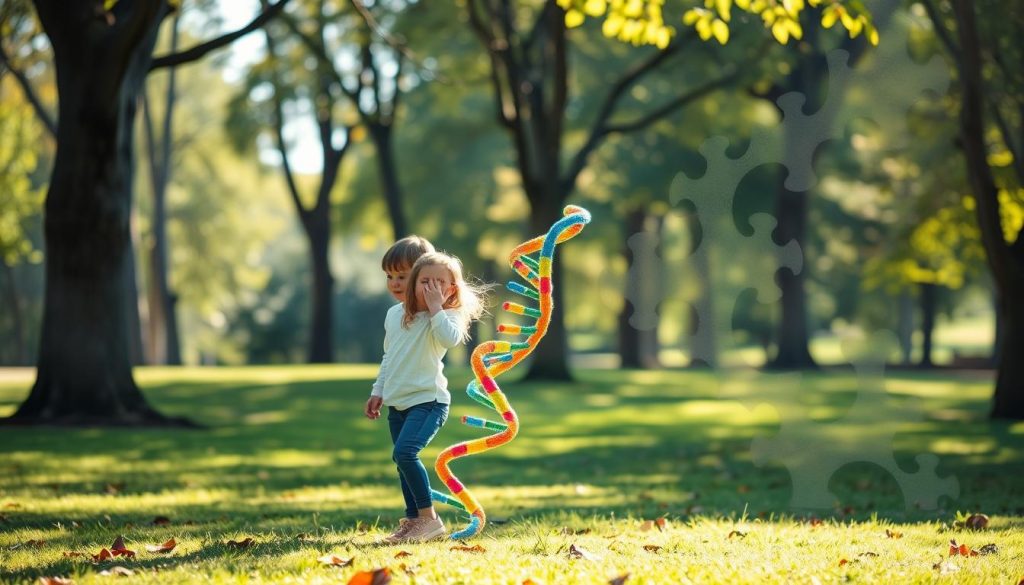
Studies reveal that younger siblings of children with autism have a 20% chance of being diagnosed with autism. This is much higher than the general population. Genetic factors are a big part of this increased risk.
Families with one child on the autism spectrum often notice subtle traits in their other children. These traits might not meet full autism criteria but show a genetic link to autism spectrum disorders.
- Shared genetic variations
- Similar environmental exposures
- Inherited gene mutations
Experts suggest keeping a close eye on younger siblings in families with autism. Early screening can lead to timely help, improving their outcomes. Genetic counseling helps families understand their risk and make informed choices about future pregnancies.
Research is ongoing to find specific genetic markers that raise sibling risk. This research will help us better understand familial autism. It could also lead to new ways to prevent neurodevelopmental disorders.
Latest Research in Autism Genetics
The study of autism genetics is moving fast. New findings are helping us understand neurodevelopmental disorders better. This progress is leading to better ways to diagnose and treat autism.
Recent Scientific Discoveries
Scientists have found new genes linked to autism. A key study showed that genetics are key in. Some genes come from dads, which changes what we thought about autism genes.
Ongoing Genetic Studies
Now, researchers are looking at how chromosomal changes affect autism. They want to know how these changes impact brain growth and how it works. Big studies are underway to find more genes linked to autism and how they work together.
Future Research Directions
The future of autism genetics research is bright. Scientists hope to create treatments tailored to each person’s genes. They plan to study epigenetics and gene therapies. As we learn more, we’ll have better ways to help those with autism.
| Research Area | Current Focus | Future Goals |
|---|---|---|
| Gene Identification | Discovering new autism-related genes | Creating complete genetic risk profiles |
| Chromosomal Abnormalities | Understanding impact on brain development | Developing targeted therapies for specific abnormalities |
| Epigenetics | Exploring environmental influences on gene expression | Identifying possible epigenetic interventions |
The Impact of Copy Number Variations
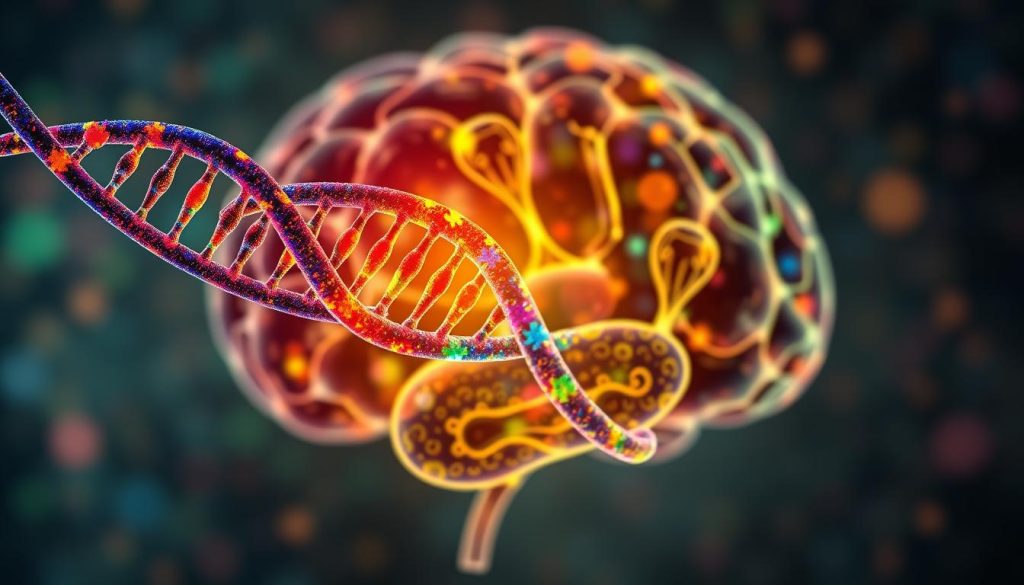
Copy number variations (CNVs) are key in autism spectrum disorders. They involve changes in DNA segments, affecting genes. This can lead to changes in brain development and function.
These genetic changes can increase the risk of autism. Studies show people with autism often have more CNVs than others.
Some CNVs linked to autism include:
- 16p11.2 deletion/duplication
- 22q11.2 deletion/duplication
- 15q11-q13 duplication
These CNVs raise the chance of autism and other neurodevelopmental disorders. Genetic testing can find these variations. This helps in diagnosis and treatment planning.
| CNV | Associated Features | Autism Risk |
|---|---|---|
| 16p11.2 deletion | Language delays, intellectual disability | 20-30% |
| 22q11.2 deletion | Heart defects, immune problems | 15-25% |
| 15q11-q13 duplication | Seizures, developmental delays | 50-80% |
Understanding CNVs is important for autism research and treatment. It helps in creating better diagnostic tools and interventions for autism spectrum disorders.
Gender Differences in Autism Inheritance
Research into autism genetics shows big differences between males and females. Boys are more often diagnosed with autism than girls. This raises questions about how genes influence autism in both genders.
Male vs. Female Presentation
Autism can look different in boys and girls. Boys usually show clear signs, while girls might hide theirs better. This can cause girls to be underdiagnosed. Scientists are looking into how genetics might explain these differences.
Sex-Linked Genetic Factors
The X chromosome is key to understanding autism’s gender gap. Girls have two X chromosomes, which might protect them from certain autism-linked mutations. Boys, with only one X chromosome, don’t have this protection. This could be why more boys are diagnosed with autism.
| Factor | Males | Females |
|---|---|---|
| X Chromosomes | 1 | 2 |
| Genetic Buffer | Lower | Higher |
| Symptom Visibility | More Apparent | Often Masked |
| Diagnosis Rate | Higher | Lower |
Paternal inheritance also affects autism risk. Older dads pass on more genetic mutations, which can raise the risk of autism in their kids. Studying these complex patterns is key to moving forward in autism genetics research. It also helps in making better diagnostic tools for both genders.
Preventive Measures and Genetic Counseling
Understanding genetic risk factors is key in managing neurodevelopmental disorders like autism. Families with a history of autism can greatly benefit from genetic counseling. This helps parents understand their chances of having a child with autism spectrum disorder.
Genetic counselors offer insights into genetic predisposition and guide on preventive measures. They suggest lifestyle changes and early interventions to lessen the impact of genetic factors linked to autism.
We can’t change our genes, but we can make informed family planning decisions. Genetic testing can show specific risk factors. This allows parents to prepare for any challenges ahead. Remember, having genetic risk factors doesn’t mean a child will definitely develop autism. It’s about being aware and ready to support them if needed.
FAQ
Q: Is autism inherited from the mother or father?
A: Autism isn’t just passed down from one parent. It comes from a mix of genes from both parents and possibly environmental factors. Both parents’ genes can play a role in the risk of autism.
Q: Are there specific genes linked to autism?
A: Yes, certain genes like SHANK3, CHD8, and SCN2A are linked to autism. But, autism usually results from a mix of many genetic changes, not just one.
Q: Can autism skip generations?
A: Yes, autism can seem to skip generations. This is because some family members might carry genetic changes without showing symptoms. Their children or grandchildren could then develop autism.
Q: Does maternal age affect autism risk?
A: Advanced maternal age might slightly raise the risk of autism in children. This could be because older eggs are more likely to have genetic or chromosomal issues.
Q: How does paternal age impact autism risk?
A: Older paternal age is linked to a higher autism risk in children. This is thought to be because older men’s sperm have more genetic mutations, which can lead to neurodevelopmental disorders.
Q: What are de novo mutations in autism?
A: De novo mutations are new genetic changes that happen spontaneously. They can increase the risk of autism and explain cases without a family history.
Q: How do environmental factors influence autism genetics?
A: Environmental factors can affect autism risk by changing how genes work. This can happen without altering the DNA itself, impacting brain development and autism risk.
Q: What is the sibling recurrence risk for autism?
A: The risk of autism in siblings is 2-18%, higher than the general population. This is because families share genetic factors that increase this risk.
Q: Are there gender differences in autism inheritance?
A: Yes, autism is diagnosed more often in males, with a 4:1 ratio. This might be due to genetic differences and how autism presents in males and females.
Q: What is genetic counseling for autism?
A: Genetic counseling for autism helps understand genetic risks. It involves working with a healthcare professional to assess risk and make informed decisions about family planning and early intervention.












